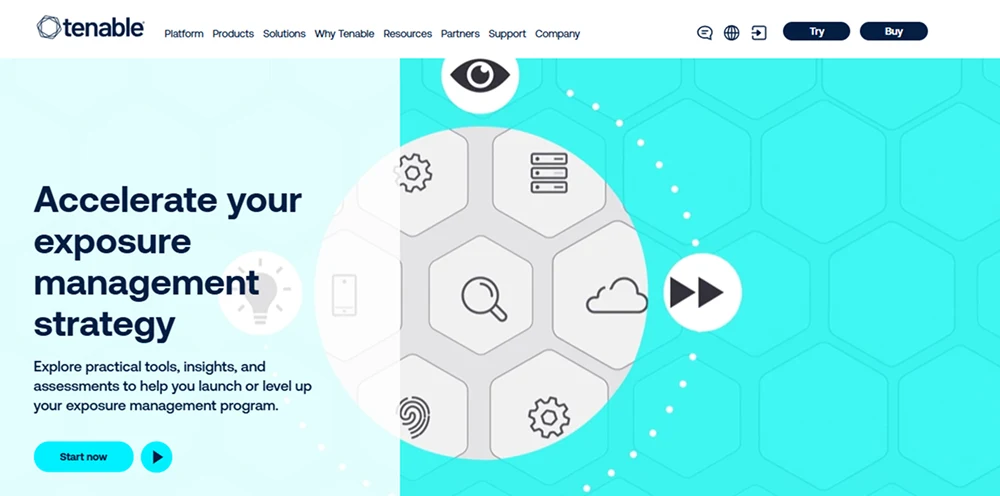Tenable Overview & 2025 Industry Position
Tenable, a global leader in cybersecurity vulnerability management, has positioned itself as an indispensable player in the modern security stack. Originally known for Nessus, the world’s most deployed vulnerability scanner, Tenable has evolved into a comprehensive platform providing unified visibility and proactive risk management across IT, cloud, OT, and DevOps environments. As we enter 2025, Tenable is redefining the cybersecurity landscape with AI-enhanced threat prediction, cloud-native support, and continuous compliance capabilities.
The need for proactive cybersecurity has never been greater, with threat actors becoming more sophisticated and attack surfaces expanding rapidly. In this high-stakes setting, Tenable’s integrated approach—powered by Tenable One—offers organizations a strategic edge by enabling context-rich risk prioritization and end-to-end exposure management.
From Launch to 2025: Tenable’s Journey
Founded in 2002 by Ron Gula, Tenable made an immediate impact with Nessus, revolutionizing vulnerability scanning with an open-source model. Here are key milestones in Tenable’s evolution:
- 2005: Nessus becomes closed source, enhancing commercial opportunities.
- 2012: Introduction of Tenable SecurityCenter for enterprise-grade analytics.
- 2017: Tenable goes public (NASDAQ: TENB), signaling market maturation.
- 2019: Launch of Tenable.io for cloud-native vulnerability management.
- 2022: Acquisition of Industrial Security companies like OTORIO and Accurics for cloud/OT coverage.
- 2023: Launch of Tenable One Exposure Management Platform to integrate cloud, IT, and identity security.
2025 Strategy Thesis: Tenable aims to become the definitive exposure management platform by fusing cloud, AI, and asset intelligence into a real-time risk prioritization and remediation engine for complex enterprise environments.

Tenable Key Features
Tenable offers a best-in-class suite of cybersecurity tools, unified under the Tenable One platform. Key features include:
- Tenable One: Unified exposure management platform combining asset visibility, threat intelligence, and risk-based prioritization.
- Nessus: Leading vulnerability scanner used in over 30,000 organizations worldwide.
- Tenable.io: SaaS-delivered cloud-native platform for web apps, containers, and cloud-based infrastructure.
- Identity Exposure: Continuous assessment of Active Directory misconfigurations and privilege paths.
- Cloud Security: Integration with AWS, Azure, GCP for posture management and context-aware scanning.
- Operational Technology: Specialized support for SCADA, ICS, and IIoT environments in critical infrastructure.
Workflow & UX
Tenable offers an intuitive and data-rich experience. The modern UI is built for scalability, making complex environments manageable for SOC teams and IT admins alike. Highlights include:
- Unified Dashboards: Configurable and role-based access views.
- Smart Visualizations: Asset maps, risk heatmaps, and exploit predictors.
- Advanced Filters: Search by CVE, risk score, asset name, or plugin ID in seconds.
- Contextual Actions: One-click remediation suggestions based on exploitability.
Pro Tip: Use Tenable’s built-in integrations with Jira or ServiceNow to streamline vulnerability assignment and ticketing across teams.
Tenable Pricing Analysis & Value Metrics
Here’s how Tenable pricing stacks up as of July 2025:
| Plan | Base Price (Annual) | Inclusions | Ideal For |
|---|---|---|---|
| Nessus Essentials | Free | Up to 16 IPs, Basic Scanning | Learners & Small Projects |
| Nessus Pro | $3,390 | Unlimited Scanning, Reporting & Plugins | Consultants & SMBs |
| Tenable.io | $22/Asset | Cloud Scanning, Container & Web App | Cloud-Native Midmarket |
| Tenable One | Custom | Risk-Based VM, Identity, OT, Cloud | Enterprises, MSSPs |
Value Summary: While premium-tier pricing can seem steep, the bundled value—especially in Tenable One—reduces breach response costs and strengthens cyber resilience across hybrid enterprise environments.
Competitive Landscape
Here’s how Tenable compares to key industry players:
| Platform | Core Strength | Best For | Notable Cons |
|---|---|---|---|
| Qualys | Continuous compliance & scanning | Large auditor-sensitive firms | Complex setup, UI is dated |
| Rapid7 | Insight-driven analytics and SIEM | Hybrid teams with SIEM needs | Price escalates with scale |
| Tenable One | Unified exposure & cloud/identity security | Enterprises, MSSPs | Initial learning curve |
| Aqua Security | Container security & DevSecOps | Cloud-native organizations | Niche beyond containers |
Use Cases
- Financial Services: Identity-aware scanning and compliance reporting.
- Healthcare: Asset discovery in regulated HITRUST and HIPAA environments.
- Manufacturing: OT/ICS support protects production environments.
- Agencies & Government: FedRAMP-ready support and robust SIEM integrations.
- Managed Security Providers: Multi-tenant dashboards for client segmentation.
Integrations & Ecosystem
Tenable integrates smoothly into modern security ecosystems, including:
- Cloud: AWS, Azure, Google Cloud via CSPM connectors.
- ITSM: Jira, ServiceNow for ticketing and escalation workflows.
- SIEM/XDR: Splunk, IBM QRadar, Microsoft Sentinel.
- CMDB & CI: BMC, FreshService, Cherwell.
- Enterprise Authentication: Okta, Azure AD, Ping Identity.
Pros & Cons
- Pros:
- Unified risk view across IT, cloud, identity, OT
- Industry-leading vulnerability detection (via Nessus)
- In-depth integrations with Jira, ServiceNow, AWS, etc.
- Flexible deployment (SaaS and on-prem)
- Cons:
- Learning curve for Tenable One’s advanced features
- Premium pricing for complex use cases
- Some dashboard visualizations require manual tuning
Final Thoughts
Tenable remains a category-defining solution in 2025, continuously pushing the bounds of risk management analytics. While it might not be the most budget-friendly platform, it delivers significant ROI for mid-to-large-scale organizations with hybrid or cloud-native infrastructures. Its ability to contextualize threats across multiple layers—asset, identity, and network—is crucial for modern cybersecurity operations.
Tenable FAQ
Tenable is used by organizations to identify, prioritize, and mitigate vulnerabilities across their digital infrastructure, from IT and cloud to identity and OT assets.
Yes. Tenable integrates with AWS, Azure, and Google Cloud to provide container, application, and infrastructure scanning with contextual risk scoring.
Nessus is a standalone scanner ideal for professionals, while Tenable.io is a SaaS platform offering broader asset visibility, compliance checks, and integrations.
Tenable uses threat intelligence, CVSS scores, asset criticality, and exploitability to generate a risk-based prioritization of vulnerabilities for focused remediation.
Yes—Tenable offers lightweight plans like Nessus Essentials and Nessus Pro geared toward consultants, SMBs, and developers starting with vulnerability assessments.